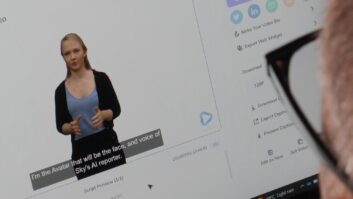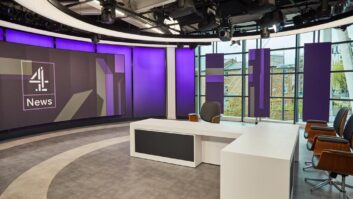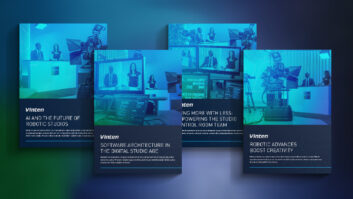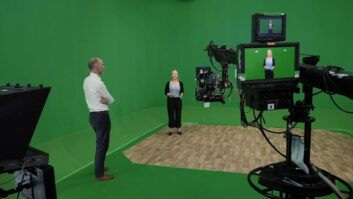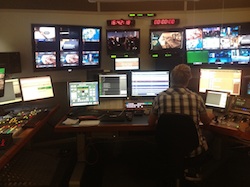
Sweden’s largest commercial network, TV4, made the decision in 2011 to expand its news coverage – a genre of its programming that already formed a major part of the service. To accomplish this aim – and to introduce a new 24-hour channel – a separate production company, Nyhetsbolaget Sverige, was set up with production and editorial staff moving from the main TV4 operation. In all, around 400 members of staff were transferred.
However, the overall arrangement is a little more complicated than a simple transfer of assets. Nyhetsbolaget Sverige doesn’t own any technical inventories, and so has to pay for the technology from TV4 as managed services. TV4 owns the news production systems, such as Electronic News Production System (ENPS), Vizrt Ardome and Hego Graphics. To complicate matters even further, TV4 doesn’t own any television technology – that is handled by EBS (Ericsson Broadcast Services). That means TV4 is paying EBS for these managed services.
Despite these complexities, the set up does work and earlier this year, TV4NEWS, the 24/7 news channel was launched from the TV4 operational base in Stockholm.
“Our format is news on the hour, with updates every 15 minutes,” explains Stefan Kurvinen, head of technology, Nyhetsbolaget Sverige.” Normally, there are five or six commercial breaks during the hour. In addition, feature programmes are scheduled every week. These include topics such as science, politics, entertainment and weather. We are also re-transmitting BBC World [Service] at various times during every day.”
Alongside the output for the channel, Nyhetsbolaget Sverige produces news and current affairs programmes for the regular TV4 outlets using the existing studio and gallery. However, to handle the production for the 24/7 channel a new gallery was constructed.
Manual to automated
Three Sony HDC1500 cameras – which were inherited from the previous TV4 news operation – are employed in the news studio. These, along with many other pieces of equipment, are under the control of a Mosart automation system.
“Although TV4 had been using automation for a good number of years, the schedules we are using for the 24-hour news channel would be just about impractical without these facilities,” states Kurvinen. “Mosart is controlling the Vinten Radamec systems, the vision mixer and audio switcher. We have a custom interface to run subtitles through Vizrt Ardome and Hego graphics.”
He says that the Sony MVS-8000 vision mixer is hardly ever used in manual mode – in fact, it is placed at the end of the production desk in the news gallery. The audio mixer chosen for the channel was a Yamaha O2R96 because of its compliance with the Mosart automation control.
“Although we have a great deal of live programming, normally there is just one editor-in-chief and one Mosart operator in the gallery for the rolling news segments. When the schedule becomes more complicated – for example, if there are live feeds or studio programmes involving guests – we add a Mosart assistant to take care of the additional tasks.”
System architecture
This automation equipment is a standard package based on open system IT standards and interfaces. It comprises a story and template based architecture which allows programme editors to place elements of the enabled hardware – vision mixer, cameras, and so on – in standby, manual or automatic mode according to programme requirements.
Using MOS (Media Object Server protocol), Mosart interprets information from the newsroom computer system – in this case ENPS – including links reading time, editorial story timing, and show and break durations. It then combines these with actual clip lengths to create a programme schedule.
“The instructions for the Mosart system are produced in the newsroom,” reveals Per Kristian Orset from Mosart. “The person creating a show can add which camera or cameras to be used for a particular story, the transitions, which ME bank to use on the mixer, what DVE moves are required, which packages to run, what graphics are needed and so on. But it is easy to alter those instructions in the gallery when the programme is on the air.”
As well as changing templates in the gallery, personnel can take over manual operation of the system should that become necessary – perhaps through live interviews running over time or other unforeseen circumstances which may affect the overall length of the programme.
“Any element in the system – the vision mixer, for example – can be disabled for a period of time and then re-enabled when the timings are back on track,” says Orset. “To ensure correct timings on a programme, the Mosart displays and the user interfaces constantly provide both visual and audio countdowns for next break, current story element, total rundown over or under and next story details.”
He goes on, “A Mosart installation in one gallery can produce, if required, multi channel outputs with different branding on the two outlets.”
The automation also controls the Omneon servers that are in place at Nyhetsbolaget Sverige. Server channels are automatically allocated for the main programme output, plus any secondary uses such as a video wall display.
Pool running order
Kurvinen admits there have been many lessons to learn over the last few months. “In time for the launch we did make significant changes to the workflow in ENPS. Bear in mind, we are also producing news programmes for other TV4 stations. We wanted to have the same production workflow – no matter if producers are editing a story for the morning news, for the seven o’clock evening show, the late night news or the 24-hour news channel. It is vital that everybody follows the same rules and procedures.”
To accomplish this goal, the team started to work with a daily pool running order – or content collection – in ENPS. All stories are created in this rundown (including generated MOS placeholders). They are prepared by the journalist/reporter, including lead-ins, Character Generation and so on. Stories are then dragged from this pool to the TX-rundowns where they are published. They can also be dragged to web-publishing rundowns for automated export to websites and also to a third party company that is distributing stories for sale. This last activity is a new – and vital – revenue stream for Nyhetsbolaget Sverige.
“Significantly, on the lead up to the launch, we had no familiarity with running a 24-hour news channel. But it has been a challenging experience and we are always looking for ways to tweak the production workflow to make things better for our viewers.”
By Philip Stevens
www.tv4.se
www.nyhetsbolaget.se
www.mosart.no
www.enps.com
www.vizrt.com
www.hegogroup.com
www.ericsson.com
www.sony.co.uk
www.vintenradamec.com
www.yamahaproaudio.com


